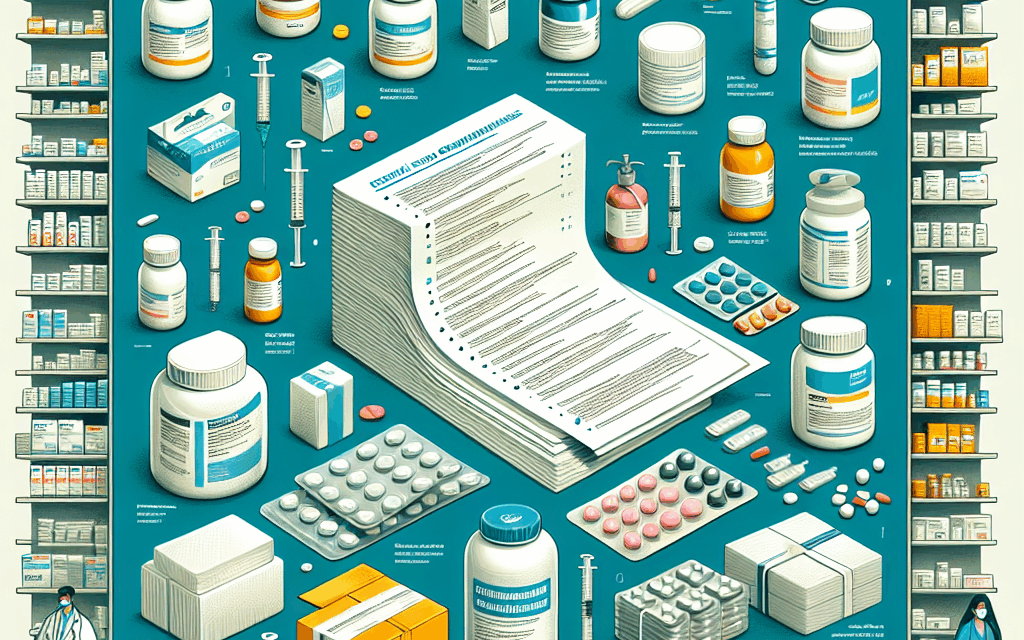Essential Compliance Guidelines for Bulk Pharmacy Supply Purchases
In the ever-evolving landscape of healthcare, pharmacies play a crucial role in ensuring that patients receive the medications they need. However, with the increasing demand for pharmaceuticals, bulk purchasing has become a common practice among pharmacies. While bulk purchasing can lead to cost savings and improved inventory management, it also comes with a host of compliance requirements that must be adhered to. This article delves into the essential compliance guidelines for bulk pharmacy supply purchases, providing valuable insights for pharmacy owners, managers, and compliance officers.
1. Understanding Regulatory Frameworks
Before engaging in bulk purchasing, it is imperative for pharmacies to understand the regulatory frameworks that govern pharmaceutical distribution. These regulations are designed to ensure the safety, efficacy, and quality of medications. The primary regulatory bodies include the Food and Drug Administration (FDA), the Drug Enforcement Administration (DEA), and state pharmacy boards.
1.1 FDA Regulations
The FDA oversees the approval and regulation of pharmaceuticals in the United States. Pharmacies must comply with the FDA’s guidelines regarding the sourcing of medications, labeling, and storage conditions. For instance, the FDA mandates that all medications must be sourced from licensed wholesalers or manufacturers. Purchasing from unlicensed sources can lead to severe penalties, including fines and loss of licensure.
1.2 DEA Regulations
The DEA regulates controlled substances, which are drugs that have a high potential for abuse. Pharmacies must adhere to strict guidelines when purchasing controlled substances in bulk. This includes maintaining accurate records of all transactions, ensuring that purchases are made only from registered suppliers, and conducting regular inventory audits to prevent diversion.
1.3 State Pharmacy Board Regulations
Each state has its own pharmacy board that enforces regulations specific to that state. These regulations can vary significantly, so it is essential for pharmacies to familiarize themselves with local laws. For example, some states may have additional requirements for record-keeping or may limit the quantity of certain medications that can be purchased at one time.
1.4 Compliance Training
To ensure adherence to these regulations, pharmacies should invest in compliance training for their staff. Regular training sessions can help employees understand the importance of compliance and stay updated on any changes in regulations. This proactive approach can mitigate the risk of non-compliance and its associated consequences.
1.5 Case Study: Compliance Failures
A notable case highlighting the importance of compliance is the 2012 fungal meningitis outbreak linked to contaminated steroids produced by a compounding pharmacy. The lack of adherence to FDA regulations resulted in tragic consequences, leading to numerous infections and deaths. This case underscores the critical need for pharmacies to prioritize compliance in their operations.
2. Establishing Supplier Relationships
Building strong relationships with suppliers is essential for pharmacies engaging in bulk purchasing. A reliable supplier can ensure the quality and availability of medications, while also helping pharmacies navigate compliance requirements.
2.1 Evaluating Suppliers
Pharmacies should conduct thorough evaluations of potential suppliers before entering into agreements. This includes assessing their licensing, reputation, and compliance history. Key factors to consider include:
- Licensing: Ensure that the supplier is licensed to distribute pharmaceuticals in your state.
- Reputation: Research the supplier’s reputation within the industry. Look for reviews and testimonials from other pharmacies.
- Compliance History: Investigate whether the supplier has faced any compliance issues in the past.
2.2 Establishing Contracts
Once a supplier has been evaluated, pharmacies should establish clear contracts that outline the terms of the relationship. Contracts should include:
- Pricing: Clearly define pricing structures and any discounts for bulk purchases.
- Delivery Terms: Specify delivery schedules and responsibilities for both parties.
- Quality Assurance: Include clauses that address quality control measures and procedures for handling defective products.
2.3 Communication and Collaboration
Effective communication is key to maintaining a successful supplier relationship. Pharmacies should establish regular communication channels to discuss inventory levels, upcoming needs, and any potential issues. Collaborative efforts can lead to better inventory management and more efficient purchasing processes.
2.4 Case Study: Successful Supplier Relationships
A pharmacy in California successfully reduced its costs by 15% by establishing a long-term relationship with a local wholesaler. By collaborating closely, they were able to negotiate better pricing and ensure timely deliveries, ultimately improving patient care through consistent medication availability.
2.5 Risk Management
Pharmacies should also consider risk management strategies when establishing supplier relationships. This includes diversifying suppliers to avoid reliance on a single source and regularly reviewing supplier performance to identify any potential risks early on.
3. Inventory Management and Control
Effective inventory management is crucial for pharmacies engaged in bulk purchasing. Proper inventory control not only ensures compliance but also enhances operational efficiency and patient safety.
3.1 Inventory Tracking Systems
Implementing an inventory tracking system can help pharmacies maintain accurate records of their stock levels. These systems can automate the tracking process, making it easier to monitor expiration dates, reorder levels, and controlled substance inventories. Key features to look for in an inventory tracking system include:
- Real-time tracking: Ability to monitor inventory levels in real-time.
- Expiration date alerts: Notifications for medications approaching their expiration dates.
- Reporting capabilities: Generate reports for compliance audits and inventory assessments.
3.2 Regular Audits
Conducting regular inventory audits is essential for ensuring compliance with regulatory requirements. Audits help identify discrepancies, prevent theft or diversion, and ensure that all medications are accounted for. Pharmacies should establish a schedule for audits, which may include:
- Monthly audits: Review inventory levels and reconcile with purchase records.
- Quarterly controlled substance audits: Conduct thorough checks of controlled substances to ensure compliance with DEA regulations.
- Annual comprehensive audits: Perform a complete inventory assessment to identify any long-term trends or issues.
3.3 Expiration Management
Managing medication expiration dates is critical for patient safety and compliance. Pharmacies should implement a system for tracking expiration dates and removing expired medications from inventory promptly. Strategies for effective expiration management include:
- First-in, first-out (FIFO): Use the FIFO method to ensure that older stock is dispensed before newer stock.
- Regular reviews: Schedule regular reviews of inventory to identify and remove expired medications.
- Donation programs: Consider partnering with local organizations to donate medications that are nearing expiration but still safe for use.
3.4 Case Study: Inventory Management Success
A pharmacy in New York implemented an advanced inventory management system that reduced medication waste by 30%. By automating tracking and expiration management, they improved compliance and enhanced patient safety, demonstrating the importance of effective inventory control.
3.5 Training Staff on Inventory Practices
Training staff on proper inventory management practices is essential for maintaining compliance. Regular training sessions can help employees understand the importance of accurate record-keeping, expiration management, and the proper handling of controlled substances.
4. Documentation and Record-Keeping
Accurate documentation and record-keeping are fundamental components of compliance in bulk pharmacy supply purchases. Pharmacies must maintain comprehensive records to demonstrate adherence to regulatory requirements and facilitate audits.
4.1 Required Documentation
Pharmacies should maintain a variety of documentation related to bulk purchases, including:
- Purchase orders: Keep records of all purchase orders placed with suppliers.
- Invoices: Retain copies of invoices for all transactions, including details of the medications purchased.
- Receiving records: Document the receipt of medications, including quantities and any discrepancies.
4.2 Electronic Record-Keeping
Utilizing electronic record-keeping systems can streamline the documentation process and enhance compliance. Electronic systems can provide secure storage, easy retrieval, and automated reporting capabilities. Key benefits of electronic record-keeping include:
- Improved accuracy: Reduce the risk of human error in record-keeping.
- Enhanced security: Protect sensitive information through secure access controls.
- Efficient audits: Simplify the audit process by providing easy access to records.
4.3 Retention Policies
Pharmacies should establish clear retention policies for documentation related to bulk purchases. Retention periods may vary based on regulatory requirements, but a common guideline is to retain records for at least five years. This ensures that pharmacies can provide documentation during audits and investigations.
4.4 Case Study: Documentation Failures
A pharmacy in Texas faced significant penalties due to inadequate record-keeping practices. During a routine audit, it was discovered that the pharmacy could not provide documentation for several bulk purchases, leading to fines and a temporary suspension of their license. This case highlights the critical importance of maintaining accurate and comprehensive records.
4.5 Training on Documentation Practices
Training staff on proper documentation practices is essential for ensuring compliance. Regular training sessions can help employees understand the importance of accurate record-keeping and familiarize them with the pharmacy’s documentation policies and procedures.
5. Risk Management and Compliance Monitoring
Implementing effective risk management strategies is vital for pharmacies engaged in bulk purchasing. Proactive monitoring and assessment of compliance risks can help prevent violations and ensure patient safety.
5.1 Identifying Compliance Risks
Pharmacies should conduct regular assessments to identify potential compliance risks associated with bulk purchasing. Common risks include:
- Supplier non-compliance: Risks associated with purchasing from unlicensed or non-compliant suppliers.
- Inventory discrepancies: Risks related to inaccurate inventory records or expired medications.
- Controlled substance diversion: Risks associated with the theft or misuse of controlled substances.
5.2 Developing a Compliance Monitoring Plan
A comprehensive compliance monitoring plan can help pharmacies proactively address potential risks. Key components of a compliance monitoring plan include:
- Regular audits: Schedule routine audits to assess compliance with regulatory requirements.
- Performance metrics: Establish key performance indicators (KPIs) to measure compliance effectiveness.
- Incident reporting: Implement a system for reporting and addressing compliance incidents promptly.
5.3 Engaging Compliance Officers
Designating a compliance officer within the pharmacy can enhance oversight and accountability. The compliance officer should be responsible for monitoring compliance activities, conducting audits, and providing training to staff. This role is critical for ensuring that compliance remains a priority within the organization.
5.4 Case Study: Effective Risk Management
A pharmacy in Florida implemented a robust compliance monitoring plan that included regular audits and staff training. As a result, they identified and addressed several compliance risks before they escalated into significant issues. This proactive approach not only improved compliance but also enhanced patient safety and trust in the pharmacy.
5.5 Continuous Improvement
Pharmacies should adopt a culture of continuous improvement when it comes to compliance. Regularly reviewing and updating compliance policies and procedures can help address emerging risks and ensure that the pharmacy remains compliant with evolving regulations.
Conclusion
Bulk pharmacy supply purchases can offer significant benefits, including cost savings and improved inventory management. However, these advantages come with a responsibility to adhere to a complex web of compliance requirements. By understanding regulatory frameworks, establishing strong supplier relationships, implementing effective inventory management practices, maintaining accurate documentation, and developing robust risk management strategies, pharmacies can navigate the challenges of bulk purchasing while ensuring patient safety and regulatory compliance.
In summary, the key takeaways for pharmacies engaging in bulk purchasing include:
- Familiarize yourself with FDA, DEA, and state regulations to ensure compliance.
- Evaluate suppliers carefully and establish clear contracts to mitigate risks.
- Implement effective inventory management systems to track medications and expiration dates.
- Maintain comprehensive documentation to support compliance efforts.
- Develop a proactive compliance monitoring plan to identify and address risks.
By prioritizing compliance, pharmacies can enhance their operations, improve patient care, and build trust within their communities.





